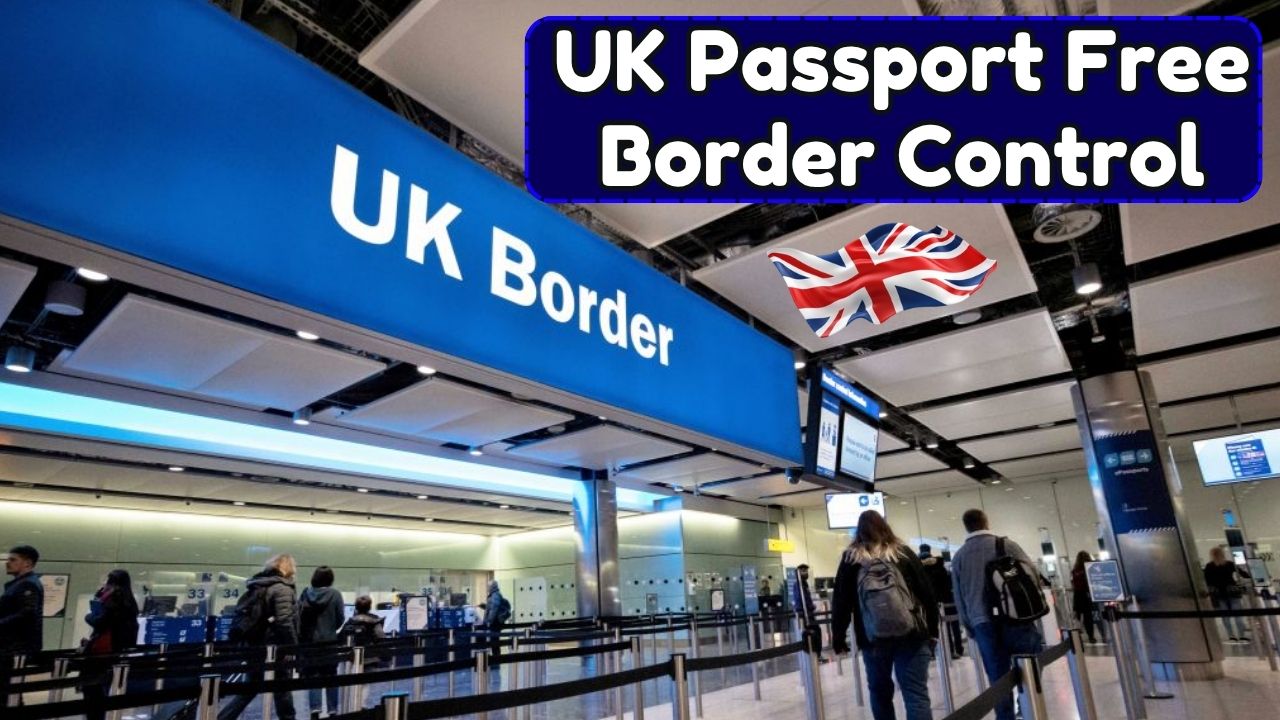The United Kingdom has taken a significant step toward modern, contactless travel by trialling a passport free border control system at Manchester Airport. During a three week pilot, selected British travellers were able to enter the country without presenting their physical passports at immigration. Instead, their identities were verified using facial recognition technology linked to existing government databases.
Officials describe this experiment as an important milestone in the creation of an intelligent, frictionless border that keeps security standards high while making the experience smoother for passengers. The trial indicates that in the near future, many travellers could pass through UK border checks using only their face as a secure digital identity token.
A New Kind Of Arrival At Manchester Airport

During the pilot at Manchester Airport, eligible British travellers arriving from abroad were invited to try the experimental contactless border lane. Instead of presenting a physical passport, they approached a specially configured e gate. Cameras at the gate captured their face and ran a real time match against secure government databases where their passport and biometric information were already stored.
If the system confirmed a match and no alerts were triggered, the gate opened and the traveller was allowed to enter the country. The entire process took only a few seconds in many cases, and did not require the passenger to hold up a document or place a passport photo page on a scanner.
Phil Douglas, director general of Border Force, summed up the new experience simply. People walk up to the gate, it recognises them because their data is already held, and they are checked through. According to Douglas, the trial showed that transaction times were considerably lower than with traditional manual checks or even standard passport scanning at e gates.
Short Summary
Key Point |
Details |
|---|---|
Main Initiative |
Trial of a contactless, passport free border control system using facial recognition at Manchester Airport. |
Location And Duration |
Manchester Airport arrivals, three week pilot with British passport holders. |
Technology Used |
AI powered facial recognition integrated into upgraded e gates, matching faces to government records. |
Main Benefits |
Faster processing times, reduced queues, more convenient experience while maintaining security checks. |
Strategic Goal |
Creation of an intelligent, frictionless border model that can be expanded to other airports and ports. |
International Context |
Aligns the UK with global leaders such as the United States, Australia and the United Arab Emirates in biometric border management. |
Official Site Link |
Building An Intelligent, Contactless Border
The Manchester trial is part of a wider transformation of British border management. For several years, the UK has been investing in e gates, advanced biometrics and digital identity systems. More than 270 e gates are already in operation at major airports and ports across the country, and new contracts are expected to expand this number further.
The long term goal is an intelligent border that combines multiple layers of security. Traditional tools such as passports, visas and watch lists are being integrated with new capabilities such as facial recognition, artificial intelligence and digital travel authorisations. The vision is to allow the majority of low risk passengers to move quickly through automated systems, while officers focus their attention on higher risk cases.
Douglas has said that it is the intention that almost everybody will pass through some kind of e gate in future. That includes not only British travellers, but potentially visitors from many partner countries whose data can be securely pre checked and verified before arrival.
Maintaining The Visible Security Check
While the focus is on speed and convenience, Border Force leaders are keen to preserve what they call the theatre of the border. This refers to the visible moment when a traveller knows they are being checked and understands that entry is subject to official scrutiny.
In practice, this means that although the system becomes more automated, passengers will still pass through a marked checkpoint with clear signage and controls. New technology will operate behind the scenes, but the impression of a formal crossing remains. According to Douglas, it is important that passengers do not feel as though the border has disappeared altogether, even if the process feels smoother and more seamless.
Results Of The Manchester Pilot And Practical Challenges
The early results from Manchester suggest that contactless processing can significantly reduce transaction times and queues. By letting the system perform an instant facial match instead of asking passengers to present documents, Border Force can clear more people per hour through the same physical space.
Interestingly, some airports have raised a different operational concern. If passengers clear immigration much more quickly, they may arrive at baggage reclaim areas before their luggage is unloaded, which could cause congestion around carousel belts rather than at passport control. Airport operators have pointed out that the entire end to end journey must be considered, not only the border checkpoint.
Despite this, the overall feedback from the pilot has been positive. The success at Manchester is expected to inform a wider rollout of contactless border processes at other major airports and seaports, subject to further testing and refinement.
Relationship With The New ETA System
The UK is also introducing an Electronic Travel Authorisation system, commonly known as ETA, for many visitors who previously entered the country without a visa. Under this scheme, travellers will submit personal details and background information online before their trip. Security agencies can then carry out checks in advance.
The ETA system has several purposes. It improves security by identifying potential risks earlier. It streamlines border processing because key data is already available and verified when the traveller arrives. It also lays the groundwork for more contactless entry through e gates, since approved visitors can have their facial biometrics linked to their digital authorisation.
For European visitors and other nationalities covered by ETA, this means that once the system is fully integrated, they could pass through e gates using facial recognition in a similar way to British passport holders, without repeated manual checks at each visit.
Britain’s Place In The Global Shift To Biometric Borders
The Manchester trial places the UK among a group of countries that are rapidly adopting biometric border solutions. The United States, Australia and the United Arab Emirates have all invested in large scale facial recognition and AI based systems for arrivals and departures.
Dubai International Airport is a widely cited example. There, an AI powered immigration corridor allows passengers to walk through without stopping at a traditional desk or scanning a passport. Cameras identify and verify up to around ten travellers at once, using real time data processing to confirm identities and flag any suspicious signals. The result is a fast moving corridor where border checks still occur, but are almost invisible to the passenger.
The UK approach shares the same fundamental goal, which is to make movement as smooth as possible while keeping borders secure. At the same time, British officials emphasise public trust, clear accountability and the need to show travellers that they are still crossing a controlled frontier.
Security, Privacy And The Passenger Experience
As contactless borders expand, questions continue to arise about privacy, data protection and oversight. Facial recognition uses highly personal biometric information. Governments must handle this data with strict safeguards, including encryption, limited retention periods and clear rules about how information can be shared.
From the passenger perspective, the main benefits are speed, predictability and reduced physical contact. Travellers no longer need to locate documents in crowded halls, and queues can move more quickly. For families and people with mobility challenges, the ability to walk up to a gate and be recognised automatically can make the arrival process less stressful.
The challenge for authorities is to balance these benefits against legitimate concerns about surveillance and the potential misuse of biometric records. Transparent communication about how the systems work, what data is stored and how it is protected will be essential to maintaining public confidence.
Frequently Asked Questions
Q1. Does the Manchester Airport trial use facial recognition to process passengers
Yes. The trial uses facial recognition technology at upgraded e gates. Cameras capture an image of each arriving passenger and match it against existing government databases that hold their biometric and passport information. If the system finds a valid match and no alerts are triggered, the gate opens and the passenger enters without showing a physical passport.
Q2. What is the purpose of the UK’s new ETA system
The Electronic Travel Authorisation system is designed to improve security and make border processing more efficient. Visitors covered by ETA submit their details online before travel so that background checks can be carried out in advance. When they arrive in the UK, their authorisation and biometric data can be used to support faster, more contactless entry through e gates.
Q3. Can non British travellers use contactless border control yet
During the Manchester pilot, the contactless system was limited to British passport holders. However, the broader plan is to extend similar technology to more nationalities over time. The UK has already opened standard e gates to several partner countries, and integration with ETA is expected to expand access further.
Q4. How does Dubai’s AI immigration corridor compare to the UK trial
Dubai’s AI powered corridor allows passengers to walk through a tunnel like space where multiple cameras automatically identify and verify travellers without them stopping or presenting documents. It can process several people at once and uses artificial intelligence to flag any irregularities. The UK trial at Manchester uses similar core technologies such as facial recognition and automated checks, although the physical layout and process are tailored to British airports and regulatory requirements.
Q5. Will passport free travel become the norm in the UK
Physical passports are likely to remain important documents for many years, especially for international travel across different jurisdictions. However, within the UK border system, the aim is for most eligible passengers to be processed through automated e gates that rely heavily on facial recognition and pre checked data. Over time, this means that for many travellers the act of showing a physical passport at the UK border could become less common, replaced by secure digital and biometric verification.
For More Information Click HERE











